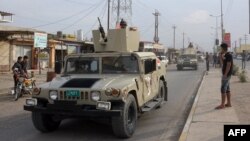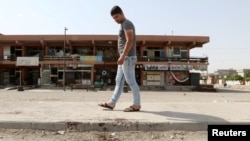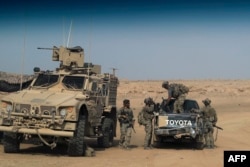Despite the anti-Islamic State campaign being waged in both Iraq and Syria, the terror group can still attack coalition forces and their local partners in both countries, Col. Sean Ryan, spokesman for the U.S.-led coalition, said.
“We are seeing small pockets of ISIS still in areas like Kirkuk and Anbar provinces,” Ryan told VOA in an interview, using an acronym for the terror group. “They are trying to disrupt civilian services, like water and electricity, to try to get the people against the government.”
Earlier this week, a bombing at a market near the Iraqi city of Mosul killed at least six people, including two soldiers. Iraqi officials accused IS of carrying out the deadly attack.
Mosul was an IS stronghold until July 2017, when Iraqi forces, with the help of the U.S.-led coalition, recaptured it. The northern Iraqi city has occasionally been targeted by IS suicide attacks.
‘Poses a constant threat’
IS also “poses a constant threat in Diyala, Salah-a-Din, Kirkuk, Nineveh and Anbar, where it uses the desert to cover its movements and carries out hit-and-run attacks,” Seth Frantzman, executive director of the Middle East Center for Reporting and Analysis (MECRA), told VOA.
Frantzman added that IS poses a particular danger “at night to civilian traffic around Hawija [in Kirkuk] and other areas. This is a reincarnation of the old ISIS insurgency network that existed between 2010 and 2013.”
Ryan said IS currently controls only 1 percent of the Syrian territory it once held when it declared its so-called caliphate in 2014.
“Right now, they still hold good presence in the middle Euphrates River Valley,” Ryan said. “That’s where the main effort and the main fight is along with our partner, the Syrian Democratic Forces. That’s their last remaining territory as well.”
The U.S.-backed, Kurdish-led Syrian Democratic Forces (SDF) have been battling IS militants in the Syrian province of Deir el-Zour. Fierce battles between the two sides are currently concentrated around the towns of Hajin and Sousa, the last remaining pockets under IS control in the eastern province.
Kino Gabriel, an SDF spokesperson, told VOA that with the U.S.-led coalition’s help, the SDF is in the last stages of its operation against IS.
“We have liberated more villages and towns of the middle Euphrates River Valley, destroying IS strongholds and command centers,” Gabriel added.
Attacking abilities
But despite these battlefield setbacks, IS is still able to stage attacks, officials said.
“It’s less about territory and more about capabilities,” coalition spokesman Ryan said.
“Every day, besides killing ISIS fighters, we’re also degrading their ammunition supply, their logistical supplies and, of course, their financing, which is very important as well,” he added.
As a result of continued attacks on the group, analyst Frantzman said, IS “has reverted to terrorism and use of tunnels or fake checkpoints in Iraq.”
And in Syria, “it is a declining military force full of the last remnants of hardened fighters. It will be defeated in conventional battle, but as a terror group will exist and may return in another form. It continues to inspire attacks globally, from Sinai [in Egypt] to the Philippines, clearly showing that it has not been defeated."
Sleeper cells
Gabriel, of the SDF, said that despite freeing most areas from IS, his group continues to deal with sleeper cells that have the capability to wage surprise attacks against anti-IS forces and civilians.
“This is another issue that [we] have constantly faced in areas we have liberated from ISIS,” he said. "They have a large number of sleeper cells that attempt to target our civilians and security forces in liberated areas.”
Analysts believe that Syria’s seven-year civil war, as well as political instability in neighboring Iraq, will continue to facilitate the resurgence of IS in different forms.
IS “is a group that feeds off political and social problems in these two countries,” said Sadradeen Kinno, a Syrian researcher who closely monitors Islamist groups in the region.
“So long as we have such problems in Syria and Iraq, IS and its ideology will remain relevant there, regardless of their military defeats,” Kinno said.
Syrian regime troops, backed by Russia, have also been engaged in a separate campaign against IS militants in parts of Deir el-Zour and the Syrian Desert, adding complexity to military operations.
Islamic State “can use the desert area between the U.S.-led coalition/SDF and the Syrian regime [and] will exploit these ungoverned spaces in Syria,” Frantzman said.
“In Iraq, it will prey on the weakness and instability in Sunni areas and the inattention the government is giving areas in Diyala and Anbar, Sinjar and Hawija,” he added.
VOA's Ali Javanmardi contributed to this report from Iraq.










